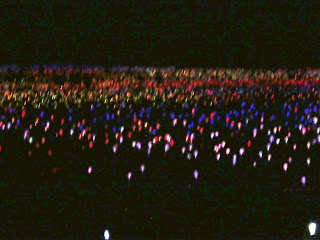July 17
After we jolted our way out of Palm Valley, once again,
driving quite a lot along the bed of the Finke River, and past the sort of
river gum and red rock landscapes made famous by Albert Namatjira who lived in
nearby Hermannsburg, we negotiated a relatively rough dirt road called the
Mereenie Loop to reach Kings Canyon Resort.
There we stayed just one night, taking a walk in the canyon
that afternoon. It’s touted as being Australia’s answer to the USA’s Grand
Canyon, but it really isn’t. There’s a longish walk around the rim we could
have done, but as that means a steep climb to start, and we really only have
two good knees between us, we opted for the shorter walk along the creek bed.
There were notices everywhere in the campground about not
feeding or encouraging the dingoes or wild dogs, and they seemed to be
everywhere, slinking around. We’d seen one trotting along the
riverbed road
that morning at Palm Valley and he seemed to be all dingo, but some of those
around the Kings Canyon Resort caravan park were real mongrels.
Anyway, on we went the next day for a short drive (on
bitumen roads) south to the Lasseter Highway, the main one from the Stuart
Highway to Uluru, and we made a stop at a cattle station called Curtin Springs,
where there is a campground. It also has a restaurant, bar and shop, and in the
past few years has been making paper from local grasses, spinifex and desert
oak needles.
We joined another couple that afternoon for a paper-making
experience, which was fascinating. The Severin family, which has run this one
million-acre station since the early 1950s, had diversified into tourism some
time ago and to perfect the papermaking, Ashley and Lindy Severin travelled to
paper-making workshops in Burnie, Tasmania. To establish the enterprise, they
cleared out an old abattoir building beside a set of working stockyards, using
a good deal of the equipment there and making what they needed out of other
bits and pieces.
That afternoon John and I each made a small piece of paper
from oats grass. They would take a few days to dry so they gave us some
completed paper to take with us. We chose some from spinifex and native couch
grass, one sheet of which was mixed with some of the tail hair they gather when
doing bangtail musters (snipping the end hair from the tails when dealing with
cattle in the stockyards so they know which ones have been into the yards, and
it’s a way of counting them).
We had a great chat at the bar that night with Ashley, a Nuffield
Scholarship winner in the 1970s, who now spends a good deal of his time dealing
with the 16 backpackers he employs and the bureaucracy from various government
departments . . . as well as his 3000 cattle.
It was less than 100km from Curtin Springs to Uluru and the
Yulara Resort, where we were booked into the campground. There are also several
hotels and apartments, a shopping centre, art galleries and a small theatre,
medical, police and fire facilities, as well as a camel farm and an airport on
the outskirts. It’s all arranged in a rough oval with a shuttle bus patrolling
every 20 minutes.
 |
An impromptu serenade
at a waterhole at the base of Uluru.
|
We did a guided tour to Uluru, about 10km away with just a
New York family as the other passengers, so had a great five hours, walking and
driving around the great rock. It looks so smooth from a distance, but is full
of folds and crevices . . . and hundreds
of tourists on the walking track around its base. Our wonderful afternoon ended
with sparkling wine as we watching the sunset change the colours of the rock, and
by then the evening cold was starting to settle.
 |
| Some of the great folds and crevices in the Rock. |
The next night was a magical experience at the Field of
Light. This is an art installation of 50,000 handcrafted light stems, each
topped with a glass globe, all working on solar power from 36 portable solar
panels. We were collected by a coach that took us to a sandhill overlooking the
area equivalent to seven football fields where the exhibition has been
installed. After being plied with bubbly and superb canapes from the local
five-star hotel, Sails in the Desert, as the light died we saw the globes
starting to glow. When they were fully lit, we descended the sandhill and
wandered the show along defined paths. There are 380km of optical fibre used in
the installation so no straying from the paths is allowed.
 |
| At sunset: The Field of Light shows white. |
Like much of the Central Australian landscape, it was
impossible to capture the sheer scale of it in photos, but like everyone else,
I tried.
 |
| Glowing in the dark. |
We’ll spend our last day restocking the pantry and fridge,
relaxing and getting ready for about five days on dirt roads, crossing the WA
border on Tuesday. We have all our permits to travel through Aboriginal lands,
big smiles on our faces, and you may not hear from us again for about a week,
depending on where we find internet access.
 |
| Spectacular globes of light in many colours. |


No comments:
Post a Comment